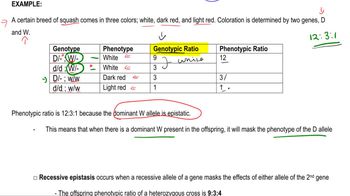Syntenic genes can assort independently. Explain this observation.
Table of contents
- 1. Introduction to Genetics51m
- 2. Mendel's Laws of Inheritance3h 37m
- 3. Extensions to Mendelian Inheritance2h 41m
- 4. Genetic Mapping and Linkage2h 28m
- 5. Genetics of Bacteria and Viruses1h 21m
- 6. Chromosomal Variation1h 48m
- 7. DNA and Chromosome Structure56m
- 8. DNA Replication1h 10m
- 9. Mitosis and Meiosis1h 34m
- 10. Transcription1h 0m
- 11. Translation58m
- 12. Gene Regulation in Prokaryotes1h 19m
- 13. Gene Regulation in Eukaryotes44m
- 14. Genetic Control of Development44m
- 15. Genomes and Genomics1h 50m
- 16. Transposable Elements47m
- 17. Mutation, Repair, and Recombination1h 6m
- 18. Molecular Genetic Tools19m
- 19. Cancer Genetics29m
- 20. Quantitative Genetics1h 26m
- 21. Population Genetics50m
- 22. Evolutionary Genetics29m
3. Extensions to Mendelian Inheritance
Understanding Independent Assortment
Problem 11b
Textbook Question
In the rats identified in Problem 10, a third independently assorting gene involved in the determination of coat color is the C gene. At this locus, the genotype C– permits expression of pigment from genes B and D. The cc genotype, however, prevents expression of coat color and results in albino rats. For each of the following crosses, determine the expected phenotype ratio of progeny.
BBDdcc×BbddCc
 Verified step by step guidance
Verified step by step guidance1
Identify the genotypes of the parents: The first parent has the genotype BBDdcc, and the second parent has the genotype BbddCc. Note that the B and D genes determine coat color, while the C gene determines whether pigment is expressed at all.
Determine the possible gametes for each parent: For the first parent (BBDdcc), the possible gametes are BDc and BDc (since it is homozygous for B and D, and homozygous recessive for c). For the second parent (BbddCc), the possible gametes are BdC, Bdc, bdC, and bdc (since it is heterozygous for B, D, and C).
Set up a Punnett square to determine the genotypes of the offspring: Combine the gametes from each parent to form all possible combinations of offspring genotypes. For example, one combination would be BDc × BdC, and so on.
Analyze the phenotypes of the offspring: The phenotype depends on the interaction of the B, D, and C genes. If the offspring has at least one dominant C allele (C–), pigment will be expressed. The B and D genes will then determine the coat color. If the offspring is cc, it will be albino regardless of the B and D alleles.
Calculate the expected phenotype ratio: Count the number of offspring with each phenotype (e.g., albino, black coat, brown coat) based on the genotypes from the Punnett square. Use the rules of inheritance to determine the proportion of each phenotype in the progeny.
 Verified video answer for a similar problem:
Verified video answer for a similar problem:This video solution was recommended by our tutors as helpful for the problem above
Video duration:
2mPlay a video:
Was this helpful?
Key Concepts
Here are the essential concepts you must grasp in order to answer the question correctly.
Independent Assortment
Independent assortment is a fundamental principle of genetics stating that alleles for different genes segregate independently of one another during gamete formation. This means that the inheritance of one trait will not affect the inheritance of another, allowing for a variety of combinations in offspring. Understanding this concept is crucial for predicting the phenotypic ratios in genetic crosses.
Recommended video:
Guided course

Gamete Genetics and Independent Assortment
Genotype and Phenotype
The genotype refers to the genetic makeup of an organism, while the phenotype is the observable physical or biochemical characteristics resulting from the genotype and environmental influences. In the context of the question, the genotypes BBDdcc and BbddCc will produce different phenotypes based on the expression of the C gene, which is essential for determining coat color in rats.
Recommended video:
Guided course

Gamete Genotypes
Epistasis
Epistasis occurs when the expression of one gene is affected by one or more other genes, leading to interactions that can mask or modify phenotypic outcomes. In this case, the C gene's influence on coat color illustrates epistasis, as the cc genotype inhibits pigment expression regardless of the presence of other color genes, which is vital for calculating the expected phenotype ratios in the progeny.
Recommended video:
Guided course

Epistatic Genes

 4:58m
4:58mWatch next
Master Gamete Genetics and Independent Assortment with a bite sized video explanation from Kylia
Start learningRelated Videos
Related Practice
Textbook Question
709
views
